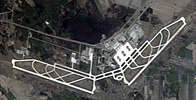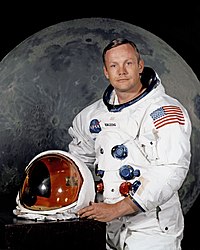Portal:Aviation
| Main page | Categories & Main topics |
|
Tasks and Projects |
The Aviation Portal

Aviation includes the activities surrounding mechanical flight and the aircraft industry. Aircraft includes fixed-wing and rotary-wing types, morphable wings, wing-less lifting bodies, as well as lighter-than-air craft such as hot air balloons and airships.
Aviation began in the 18th century with the development of the hot air balloon, an apparatus capable of atmospheric displacement through buoyancy. Some of the most significant advancements in aviation technology came with the controlled gliding flying of Otto Lilienthal in 1896; then a large step in significance came with the construction of the first powered airplane by the Wright brothers in the early 1900s. Since that time, aviation has been technologically revolutionized by the introduction of the jet which permitted a major form of transport throughout the world. (Full article...)
Selected article
The airport's location and lack of transport links, as well as Montreal's economic decline relative to Toronto, made it unpopular with airlines. Eventually relegated to the simple role of a cargo airport, Mirabel became an embarrassment widely regarded in Canada as being a boondoggle, or a "white elephant," and one of the best examples of a failed megaproject. (Full article...)
Selected image
Did you know
...that Suriname's worst air disaster was Surinam Airways Flight 764, which crashed after the pilots ignored repeated warnings that they were flying too low? ...that Frenchman Jean-Marie Le Bris accomplished the world's first powered flight in 1856, with a glider that was pulled behind a running horse? ...that a Cambridge University society has launched high altitude balloons that have taken a picture of the earth's curvature from a height of 32 km?
General images -
In the news
- May 29: Austrian Airlines cancels Moscow-bound flight after Russia refuses a reroute outside Belarusian airspace
- August 8: Passenger flight crashes upon landing at Calicut airport in India
- June 4: Power firm helicopter strikes cables, crashes near Fairfield, California
- January 29: Former basketball player Kobe Bryant dies in helicopter crash, aged 41
- January 13: Iran admits downing Ukrainian jet, cites 'human error'
- January 10: Fire erupts in parking structure at Sola Airport, Norway
- October 27: US announces restrictions on flying to Cuba
- October 3: World War II era plane crashes in Connecticut, US, killing at least seven
- September 10: Nevada prop plane crash near Las Vegas leaves two dead, three injured
- August 6: French inventor Franky Zapata successfully crosses English Channel on jet-powered hoverboard
Related portals
Associated Wikimedia
The following Wikimedia Foundation sister projects provide more on this subject:
-
Commons
Free media repository -
Wikibooks
Free textbooks and manuals -
Wikidata
Free knowledge base -
Wikinews
Free-content news -
Wikiquote
Collection of quotations -
Wikisource
Free-content library -
Wikiversity
Free learning tools -
Wikivoyage
Free travel guide -
Wiktionary
Dictionary and thesaurus
Selected biography
Before becoming an astronaut, Armstrong was in the United States Navy and saw action in the Korean War. After the war, he served as a test pilot at the National Advisory Committee for Aeronautics (NACA) High-Speed Flight Station, now known as the Dryden Flight Research Center, where he flew over 900 flights in a variety of aircraft. As a research pilot, Armstrong served as project pilot on the F-100 Super Sabre A and C aircraft, F-101 Voodoo, and the Lockheed F-104A Starfighter. He also flew the Bell X-1B, Bell X-5, North American X-15, F-105 Thunderchief, F-106 Delta Dart, B-47 Stratojet, KC-135 Stratotanker and Paresev. He graduated from Purdue University.
Selected Aircraft
[[File:|right|250px|]] The Tupolev TB-3 (Russian: Тяжёлый Бомбардировщик, Tyazholy Bombardirovschik, Heavy Bomber, civilian designation ANT-6) was a heavy bomber aircraft which was deployed by the Soviet Air Force in the 1930s and during World War II. It was the world's first cantilever wing four-engine heavy bomber. Despite obsolescence and being officially withdrawn from service in 1939, TB-3 performed bomber and transport duties through much of WWII. The TB-3 also saw combat as a Zveno project fighter mothership and as a light tank transport.
- Span: 41.80 m (137 ft 2 in)
- Length: 24.4 m (80 ft 1 in)
- Height: 8.50 m (27 ft 11 in)
- Engines: 4× Mikulin M-17F V12 engines, 525 kW (705 hp) each
- Maximum Speed: 196 km/h (106 knots, 122 mph) at 3000 m (9,840 ft)
- First Flight: 22 December 1930
Today in Aviation
- 2010 – Tajik National Guard Helicopter crash was an accident that occurred when a Mi-8 military helicopter from the Tajik National Guard crashed in the Rasht Valley close to Ezgand and Tavildara. The helicopter got caught in power lines and crashed while attempting to land. It caught fire; there were no survivors.
- 2008 – Deceased: Richard Heyser, 81, American U-2 pilot during the Cuban missile crisis.
- 2005 – A small aircraft carrying cargo for FedEx, including six vials of research viruses, crashes in downtown Winnipeg. The female pilot, the only occupant, is killed but there are no injuries on the ground.
- 1993 – Larry Walters, American “lawn chair” pilot dies. (b. 1949) He took flight on July 2, 1982 in a homemade aircraft constructed out of a patio chair and 45 helium-filled weather balloons. He reached an altitude of 16,000 feet (3 miles) and floated from San Pedro, California into federal airspace near Long Beah airport.
- 1990 – Launch: Space Shuttle Discovery STS-41 at 11:47:15 UTC. Mission highlights: Ulysses/IUS solar probe deployment.
- 1984 – First flight of the FMA IA 63 Pampa
- 1966 – First flight of the Bell OH-58 Kiowa (OH-58A)
- 1981 – NLM CityHopper Flight 431, a Fokker F28 Fellowship, is destroyed in flight by a tornado near Rotterdam, killing all 17 people on board.
- 1977 – The first prototype of the Mikoyan MiG-29, designated 9-01, makes its maiden flight.
- 1976 – Cubana de Aviación Flight 455, a Douglas DC-8, is bombed by anti-Castro militants and crashes near Bridgetown, Barbados, killing all 73 people on board.
- 1973 – Egypt and Syria launch air strikes on Israel, starting the Yom Kippur War. The conflict lasts 18 days.
- 1962 – The U.S. Marine Corps and U.S. Navy suffer their first helicopter fatalities in Vietnam when a Marine Corps UH-34 Seahorse crashes 15 miles (24 km) from Tam Ky, South Vietnam, killing five Marines and two Navy personnel.
- 1956 – A USAF Lockheed T-33A Shooting Star overruns runway while landing at Mitchel AFB, Long Island, New York, runs through perimeter fence, flips over, ending up on the Hempstead Turnpike. Pilot Maj. Daniel Kramer killed, three in an automobile are injured.
- 1955 – United Airlines Flight 409, a Douglas DC-4, crashes into Medicine Bow Peak near Centennial, Wyoming, killing all 66 on board.
- 1955 – First flight of the Convair CV-440 Metropolitan
- 1955 – McDonnell company test pilot George Shirley Mills bails out of McDonnell F3H-2N Demon over Carrollton, Illinois near St. Louis, Missouri after what appears to be a massive systems failure, including the J40 engine. Instead of crashing, fighter circles over two states for more than an hour sans canopy, ejection seat and pilot. It eventually impacts in cornfield near Monticello, Iowa, 250 miles (400 km) from ejection.
- 1954 – First flight of the Fairey FD.2.
- 1948 – United States Air Force Boeing B-29-100-BW Superfortress, 45-21866, of the 3150th Electronics Squadron, crashed in Waycross, Georgia shortly after take off from Robins Air Force Base due to an engine fire. Of the 13 men aboard 9 are killed including 3 RCA engineers. Four parachuted to safety.
- 1944 – No. 6 (RCAF) Group sent 293 bombers to attack Dortmund, Germany. This was the largest force sent out by the Group.
- 1944 – Cancelled: Fisher P-75 Eagle.
- 1944 – Junkers Ju 90, G6+AY, blows two tires and crashes on landing at Tatoi Airport, Greece, after flight from Iraklion, Crete. Repairs prove impossible and the aircraft is set on fire by the crew to prevent capture by the British, who were about to occupy Greece.
- 1939 – First flight of the Curtiss SO3C Seamew
- 1927 – Western Canada Airways commenced contract airmail service between Lac du Bonnet, Wadhope and Bisset, Manitoba.
- 1923 – Curtiss R2Cs win first and second place in the Pulitzer air race, the winning aircraft setting a new airspeed record of 243.6 mph (392 km/h).
- 1922 – Lt John A. Macready and Lt Oakley G. Kelly set a flight endurance record of 35 hours 18 min in a Fokker T-2.
- 1912 – At Oppama, Japan, Lieutenant Yōzō Kaneko makes the Imperial Japanese Navy's first flight, piloting a Farman seaplane for 15 min and reaching an altitude of 30 m (100 feet).
- 1908 – Wilbur Wright and a French writer make the first passenger flight of over one hour.
References
- Shortcuts to this page: Portal:Airplanes • P:AVIA






















































